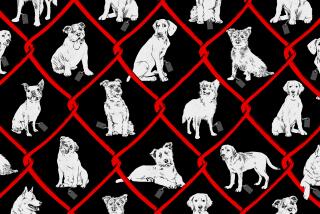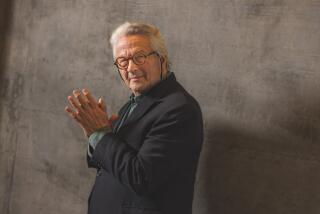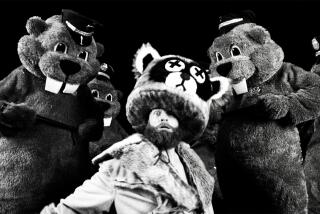A Militia of Dr. Dolittles : ‘Babe’ Called On 58 Trainers for Its Cast of More Than 900 Animals
It had the makings of a nightmare: Corralling, calming, cajoling and ultimately coaxing top-flight performances from 48 pigs, 37 mice, 30 ducks, eight dogs, four cats, two horses and a cow. Not to mention a supporting cast of nearly 800 sheep.
But veteran animal trainer Karl Lewis Miller relished the challenge--his most extensive in a 30-year career--and thus came to fruition “Babe,” a fable of a cuddly pig who defies convention and discovers his special talent while living on a farm.
For the record:
12:00 a.m. Aug. 10, 1995 For the Record
Los Angeles Times Thursday August 10, 1995 Home Edition Calendar Part F Page 2 Entertainment Desk 1 inches; 28 words Type of Material: Correction
‘Babe’ watchers-- A story in the Saturday Calendar section incorrectly identified the organization that oversaw the humane treatment of the animals on the set of “Babe.” It is the American Humane Assn.
Miller was the film’s supervising animal trainer, but given that “Babe”--based on Dick King-Smith’s 1983 children’s book “The Sheep-Pig”--called for more than 900 barnyard animals, he needed an additional 57 trainers to work with him, as well as two on-site veterinarians.
“No one has ever quite done anything on the scale of this before,” said “Babe” director Chris Noonan. “It was like a huge military operation in a way.”
Eight months before shooting began, Miller and company moved to Robertson, Australia, a small town 60 miles south of Sydney, and raised four dozen pigs who all played the title character at various stages, systematically training at least a dozen species of animals. Miller mapped out an elaborate training plan in which animals learned their commands, then were slowly introduced to the other species.
“We hand-raised the pigs from birth and bottle-fed them, so we’d have their immediate attention,” Miller said. “We became their mother, father, brother and sisters. If they wanted to play, they came to us; if they wanted food, they came to us; if they wanted protection, they came to us.”
Porcine thespians portraying Babe were between 16 and 18 weeks old.
“In our approach to training we broke it up like educating a child,” Miller said. “We would start them with small simple steps, like taking them out, socializing them. Then we’d get them used to the set, the lighting and camera equipment. Then we’d move up to basic commands in a small area. Then we would issue the commands and add distractions, like tossing a handful of gravel their way, and eventually let a cat walk by them. . . . It’s a long process, but in this way, no animal was asked to do something that he was not prepared to do.”
The toughest scene, according to Miller, involved Babe teaming up with a duck named Ferdy to steal an alarm clock. Ten weeks of rehearsal went into the five-minute sequence.
“For a pig to pick up a clock with its snout and carry it around in the direction we wanted him to go was really difficult,” Miller said.
For scenes inside the barn, in which about 20 animals would congregate and chat each other up (with moving lips, thanks to the magic of computer graphics and animatronics), each animal had to be brought in one at a time and posed. Then they had to hold their mark, which took considerable maneuvering.
“Literally it took 20 trainers to get this set up,” Miller said.
(Miller worked closely with Australia’s Society for the Prevention of Cruelty to Animals during the production and locally, a spokeswoman from the Humane Society called him “tremendously reputable.”)
*
Ironically, the soft-spoken Miller--who began by training guard dogs in the Air Force--has made his reputation as an expert animal wrangler in movies calling for vicious animals, or at least vicious performances. His specialty until recently had been creating illusions of ferocity in such films as “Cujo” and “The Doberman Gang.”
“In the industry I’m known for blood and guts,” Miller said with characteristic matter-of-factness.
Though Miller has always been partial to dogs, after working on “Babe” he was struck by the keen intelligence of pigs.
“What it takes eight to 12 months for a dog to learn, a pig can learn in 10 to 12 weeks,” Miller said. “And they are very sociable animals that do not mind the presence of people.”
Some pigs had more of a star presence than others, Miller said, in particular remembering one from an early litter named Angie.
“She had a look and an expression about her,” Miller said. “She had a charisma.”
And like other actors who are aware of their powerful persona, she was not above being temperamental. Sometimes, she would simply wander from her “dressing room” cage and walk off the set.
“It was like she was saying, ‘Hey, you’re not rolling camera very quickly. You can find me in the shade when you’re ready,’ ” Miller said.
Miller is used to interpreting the ways of animals. In addition to his movie work, he runs a large training facility and kennel in the San Fernando Valley that houses 47 dogs, a dozen cats and 600 hamsters for sale.
“What Karl does is get an emotional performance out of his creatures,” director Noonan said. “The audience has to get into the head of these animals and then completely believe the emotions that these animals were going through. . . . Karl had the patience to allow me to keep going until I got what I needed and he also had the guile to be able to work out strategies to make the animal project that emotion.”
One simple strategy was to give each animal a different sound to respond to: Pigs reacted to a clicker, ducks to a buzzer, sheep to a whistle and dogs to their trainer’s voice. When all the commands were issued simultaneously, the din was a bit disconcerting, if not downright chaotic, Noonan said.
“It was like a kindergarten makeshift band going on,” Miller recalled.
He had tricks for every conceivable kind of action--for instance, when a male and female dog “fight,” it’s actually two female dogs playing roughly with string muzzles on.
Miller is quick to point out that animatronic clones of the animals were interspersed with the real thing but he defies the average viewer to be able to tell them apart. Animatronic animals function something like robots, with facial features and limbs that move, manipulated by high-tech puppeteers. Each animal performer had its own remote-controlled stand-in.
Because of the complexity of getting animals to “act” on demand, each scene was shot several times, once with real animals, once with only animatronic animals and still again with a mixture of real and animatronic animals. For example, in a scene in which Babe addresses a flock of sheep and two or three of the sheep have dialogue, the speaking sheep were animatronic animals intermingled with live sheep.
“I watched the finished product,” Miller said, “and I found I couldn’t tell which were the real animals and which were animatronic because I was so caught up in the story.”
More to Read
Only good movies
Get the Indie Focus newsletter, Mark Olsen's weekly guide to the world of cinema.
You may occasionally receive promotional content from the Los Angeles Times.










